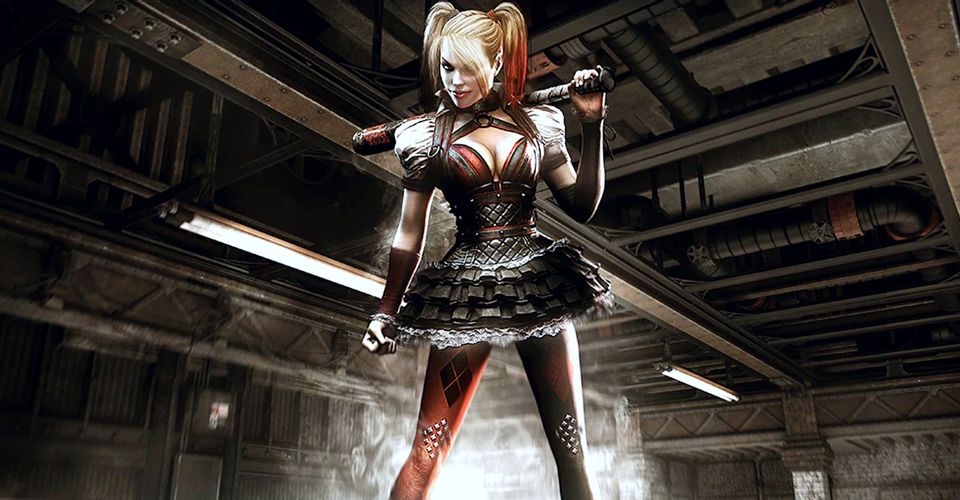How Batman: Arkham Changed Harley Quinn Forever

There have been many different iterations of Harley Quinn across all forms of media, but Batman: Arkham played a huge part in changing the character from her initial henchwoman role. Harley was originally intended to make a one-time appearance in Batman: The Animated Series, but she became so popular that she was made a permanent member of the cast. However, it wasn’t until her appearance in Batman: Arkham Asylum and the subsequent games that Harley Quinn became the iconic character she is today.
The Batman: Arkham games gave villains like Harley Quinn a chance to shine as their own dynamic characters with emotional depth and some serious skills. In Batman: The Animated Series, Harley was included as the comic relief, but she clearly had much more to offer. Not only did the Batman: Arkham series change Harley’s look, but it revamped her personality as well.
Before Batman: Arkham City, Harley Quinn was only played by one voice actor: Arleen Sorkin. Harley was inspired by Sorkin, but she also needed to evolve from her origins to develop into a true challenge for Batman. Throughout the Batman: Arkham games, Harley becomes more and more twisted and presents a greater threat to Batman with each title. The differences between each Harley in the games have inspired a completely new Harley Quinn in movies, comics, and all forms of media.
Harley Quinn Before Batman: Arkham

Harley Quinn first appeared in episode 22 of Batman: The Animated Series, “Joker’s Favor.” Harley was created as a secondary comic relief character who was blindly devoted to the Joker. She had a few spinoff storylines, but nothing serious or show-altering. Harley also didn’t have much in the way of character development that didn’t revolve around the Joker. Even Harley’s origin story doubles as a Joker storyline. However, after the initial reception and praise for Harley Quinn, the character started becoming more dynamic.
Originally inspired by actor Arleen Sorkin, Harley Quinn wore a traditional jester outfit as she took on the role of a henchwoman, but she quickly got fans’ attention. Harley had a short solo comic run from 2002-2004 before she was completely revamped in the Batman: Arkham series in 2011. After her appearance as an individual villain with a new look, and a new voice actor from Batman: Arkham City and on, Harley Quinn began to change in all forms of media.
How Harley Quinn Evolved in the Batman: Arkham Series

From the very beginning of Batman: Arkham Asylum, Harley Quinn is shown as a powerful adversary. While Joker is being escorted into the building, Harley has the Warden tied up and is monitoring the event. This shows that Harley has the capacity to take over Arkham Asylum without the Joker. She likely had help from his crew, but Harley was perfectly capable of living and working separately from the Joker, and this wasn’t portrayed much before the game. Harley thwarts Batman’s plans by dropping an elevator on him and goes against Joker’s wishes by freeing Poison Ivy. Batman: Arkham Asylum shows Harley Quinn as an individual, and although she’s still in a relationship with the Joker, it doesn’t define her character in this game.
In Batman: Arkham City and Batman: Arkham Knight, Harley Quinn becomes more and more independent, eventually branching out on her own after the Joker dies. Harley takes charge of Joker’s crew in Batman: Arkham City while the Joker is resting due to his infection, and she runs her own crew in Arkham Knight. With a more dramatic role and a lot more skin showing in her various in-game costumes, Harley is more dynamic in the Batman: Arkham series than in Batman: The Animated Series, and she is much less childlike in nature. Although a lot of her story still revolves around the Joker, and her revenge after he dies, her behavior, personality, and costume changes inspired a modern and more interesting Harley Quinn.
Batman: Arkham’s Influence In The New 52 Comics’ Harley Quinn

After Batman: Arkham Asylum came out, Harley Quinn’s appearance in the comics completely changed. She went from a full bodysuit to much less clothing and a curvier figure. Her uniform is arguably better in Batman: Arkham Asylum than her original jester costume and the outfits that followed in the sequels further developed the unique style Harley is now known for. The Batman: Arkham series is also responsible for Harley’s signature pigtails, which replaced her jester hat.
Along with completely redoing Harley’s appearance, the changes Batman: Arkham made to her personality allowed for Harley-based storylines separate from the Joker. Harley developed into an anti-hero when she was first brought into the Suicide Squad in the New 52 comics. Initially, she goes on a killing spree as revenge for the Joker being locked up, but her story develops into a fully formed character arc as she lives a life away from the Joker.
Her story is still tied to the Joker, and her betrayal of the Suicide Squad is directly related to his supposed death, but she also shines as an individual and a well-trained, murderous anti-hero. She even has a brief fling with Deadshot and denies the Joker when he comes for her, which further separates Harley from him. After declaring she no longer loves the Joker, Harley completely cuts ties with him and doesn’t return to him like she normally does. Without the Batman: Arkham series, these changes wouldn’t have happened so quickly.
The Future of Harley Quinn After Batman: Arkham

After all the changes made to Harley Quinn, there’s a lot that players can expect in regards to the future of this character. Suicide Squad: Kill the Justice League, which is being developed by the creators of the Batman: Arkham series, will feature another new iteration of Harley Quinn. Her new design seems to be inspired by the live-action version portrayed by Margot Robbie, although, as in previous Rocksteady games, she is being voiced by Tara Strong.
All of the new iterations of Harley Quinn started with the 2011 release of Batman: Arkham Asylum. Pulling Harley out of her traditional role and costume, and developing her character, helped to make the live-action movies and the New 52 comics possible. Suicide Squad: Kill the Justice League‘s Harley Quinn pulls inspiration from all the different versions that came before her, including those in the Batman: Arkham series, and her character will greatly benefit from that.
About The Author

















